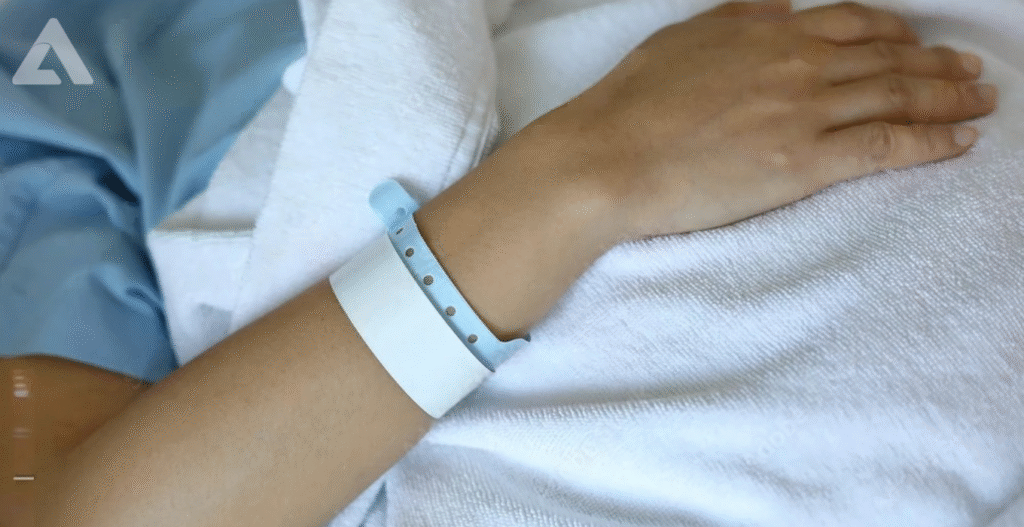Hospital & Patient ID Wristbands: The Essential Guide to Safety, Comfort & Customization
Ever Been Worried About Medical Mistakes During a Hospital Stay? Here’s How Hospital Wristbands Solve That Problem. When you or a loved one is admitted to a hospital, the last thing you want is to worry about being given the wrong medication or treatment. Unfortunately, mix-ups happen due to patient misidentification — a serious issue that can put lives at risk.
That’s where hospital wristbands come in. These wristbands carry vital patient information and alert healthcare workers to allergies, medical conditions, and important details. When patients wear a hospital wristband, staff can accurately identify them, which prevents errors and keeps care safe and reliable.
Medical Grade Patient ID Wristbands for Efficient Patient Identification
A hospital wristband is a secure, tamper-evident bracelet worn by patients, typically upon admission, to display vital information. These wristbands can include:
- Patient’s full name
- Date of birth
- Unique medical record number (MRN)
- Admission date and time
- Barcodes or RFID chips for scanning
Medical professionals rely on this data to correctly administer treatment, medication, and care. In high-pressure environments like emergency rooms or surgical theaters, wristbands eliminate confusion and save lives by ensuring the right patient gets the right procedure.

What Is a Patient ID Wristband and Why Is It Useful?
Hospital wristbands are more than ID tags — they are tools for safety, efficiency, and accountability. They are used to:
- Prevent medication errors
- Link patients to electronic health records (EHRs)
- Support infection control by reducing unnecessary contact
- Identify patients with special needs (e.g., allergies, fall risk)
Solid-colored wristbands are often used in triage to indicate condition severity, while alert wristbands use color codes to signal specific health statuses or warnings. For example:
- Red: Allergies
- Yellow: Fall risk
- Purple: Do Not Resuscitate (DNR)
- Green: Latex allergy
These visual indicators allow staff to respond quickly and appropriately, particularly during shift changes or emergencies.
Types of Patient ID Wristbands
There is no one-size-fits-all approach to patient identification. Hospitals choose different wristband types based on use cases, budgets, and patient demographics.
1. Thermal Hospital Wristbands
Printed using direct thermal printers, these are ideal for high-volume settings like ERs or admissions desks. They are cost-effective and produce crisp, scannable barcodes.
2. Laser Wristbands
Designed for use with standard laser printers, these bands offer flexibility for hospitals that print both wristbands and patient labels from a single sheet.
3. RFID Hospital Wristbands
These smart wristbands are embedded with radio-frequency identification (RFID) chips. They support real-time patient tracking, contactless medication administration, and integration with hospital software systems.
Benefits of RFID wristbands:
- Faster patient check-ins
- Accurate medication and transfusion matching
- Better infection control (no-touch scanning)
- Audit trails for compliance
4. Shield & Insert Hospital Wristbands
These include a clear shield that protects printed information from water, chemicals, and wear. Inserts are great for facilities that use pre-printed cards or labels.
5. Handwritten & Imprinted Wristbands
Medical staff can quickly fill in these wristbands with vital patient data, making them ideal for temporary or emergency use. Some hospitals still rely on imprinter wristbands, which use embossing to transfer patient info onto charts.
6. Alert Wristbands & Snaps
Color-coded and snap-on designs make it easy for clinicians to identify special care needs. Tamper-evident snaps ensure that no one swaps or removes wristbands without authorization.
7. Blood Bands
Used in blood transfusions, these wristbands help match donor units with patients to prevent dangerous mismatches.
8. Mother & Infant Wristbands
These come in matched sets with identical identification numbers to avoid mix-ups in maternity wards. Velcro closures are gentle on newborn skin.
Design Hospital Wristbands: Customization That Matters
Hospitals can customize wristbands using design tools available on provider websites. These features typically include:
- Hospital name and logo
- Color selection for alerts or branding
- Custom fields for writing notes or data
- Options for barcodes, QR codes, and RFID tags
Designing custom wristbands improves operational consistency and simplifies restocking. A well-designed band enhances both aesthetics and functionality — two elements that matter when dealing with diverse patient populations.
Hospital Wristband Uses Beyond the Wrist
Hospital wristbands are not limited to wrists. Facilities use them in innovative ways, such as:
- Equipment labeling: Bands can identify devices by patient or function.
- Room tags: To alert staff about isolation or special procedures.
- Sample labeling: Ensuring test tubes or vials are properly matched to the patient.
Color-coded wristbands can also align with hospital-wide standards or compliance protocols, making them useful beyond individual care.

Features of Our Hospital Wristbands
Comfort
Hospital wristbands are designed with patient comfort in mind. Key features include:
- Soft materials with smooth edges
- Adjustable sizing
- Latex-free and hypoallergenic components
- Gentle Velcro options for newborns
Patients may wear wristbands for days or weeks, so comfort is non-negotiable.
Security
Wristbands are tamper-evident, with closures that cannot be reused. Common types include:
- Adhesive seals
- Snap-on fasteners
- RFID authentication
This helps prevent unauthorized removal or swapping — critical for psychiatric or pediatric wards.
Wristbands for All Sizes
From premature infants to bariatric patients, our wristbands come in a wide range of sizes. Extender options allow further customization.
Resistance
Hospital wristbands must withstand harsh environments. Our bands are:
- Waterproof
- Solvent-resistant (disinfectants, detergents, iodine)
- Tear-resistant
This durability ensures information remains intact through bathing, sanitizing, and active care.
Colours
Color-coded wristbands are used as visual indicators for patient status or needs. Each color serves a purpose:
- Blue: Standard patient ID
- Red: Allergy
- Yellow: Fall risk
- Green: Latex allergy
- Purple: DNR
- Pink: Limb restrictions
These systems reduce communication errors and standardize patient care.
Benefits of Hospital Wristbands
Using hospital wristbands creates measurable benefits across the facility:
- Error prevention: Reduces risk of misidentification, especially during surgery or medication rounds.
- Workflow efficiency: Barcode and RFID integration streamline data entry and tracking.
- Improved patient safety: Staff can make quick, informed decisions with visible alerts and accurate IDs.
- Regulatory compliance: Meets safety standards from Joint Commission, WHO, and local health authorities.
According to a report by the Journal of Patient Safety, over 7,000 deaths annually are caused by medication errors — many of which are preventable with proper patient ID protocols like wristbands.

Hospital Wristbands & Digital Transformation
As hospitals undergo digital transformation, wristbands continue to evolve. Modern solutions now include:
- NFC wristbands: Patients can tap their band for self-check-in or room access.
- EHR integration: Wristbands sync with digital health records, updating patient status in real time.
- Smart wristbands: Some models track vital signs or send alerts during emergencies.
In smart hospitals, these tools help reduce administrative burden and enhance patient experiences.

Frequently Asked Questions
How long should a hospital wristband last?
Most hospital wristbands are designed to last 7–14 days. RFID and shielded types may last longer, depending on the patient’s length of stay.
Are hospital wristbands HIPAA compliant?
Yes, when used correctly. Information is encoded or shielded to prevent unauthorized access. Barcodes and RFID chips are encrypted for additional privacy.
Can wristbands be recycled or reused?
Most are single-use for hygiene and security reasons. However, eco-friendly and recyclable materials are becoming more common.
What is a patient who is wearing a medical alert bracelet?
A patient wearing a medical alert bracelet has a condition or allergy that needs to be known in emergencies, such as diabetes, allergies, or a DNR order.
What is the purpose of wristbands?
Wristbands help identify patients, reduce medical errors, and communicate important health information to medical staff.
What do the colors of wrist bands mean?
Colors indicate specific alerts:
- Red: Allergy
- Yellow: Fall risk
- Purple: Do Not Resuscitate (DNR)
- Green: Latex allergy
- Pink: Limb alert
- Blue: General ID
Why do hospitals give you a bracelet?
To safely identify you, match treatments to your records, and reduce the risk of medical errors during your stay.
What do the wristbands mean in hospitals?
They show ID, medical alerts, and treatment info, helping staff make quick, accurate decisions about your care.
Final Thoughts: Why Hospital Wristbands Matter More Than Ever
Hospital wristbands have become indispensable in the modern healthcare landscape. From basic ID to complex data integration, these small but mighty tools help ensure that patients receive the right care, at the right time, with maximum safety.
Whether you’re a healthcare administrator, supply manager, or medical professional, choosing the right wristband system is critical for operational success. To explore your options or request samples, connect with a wristband specialist today.


